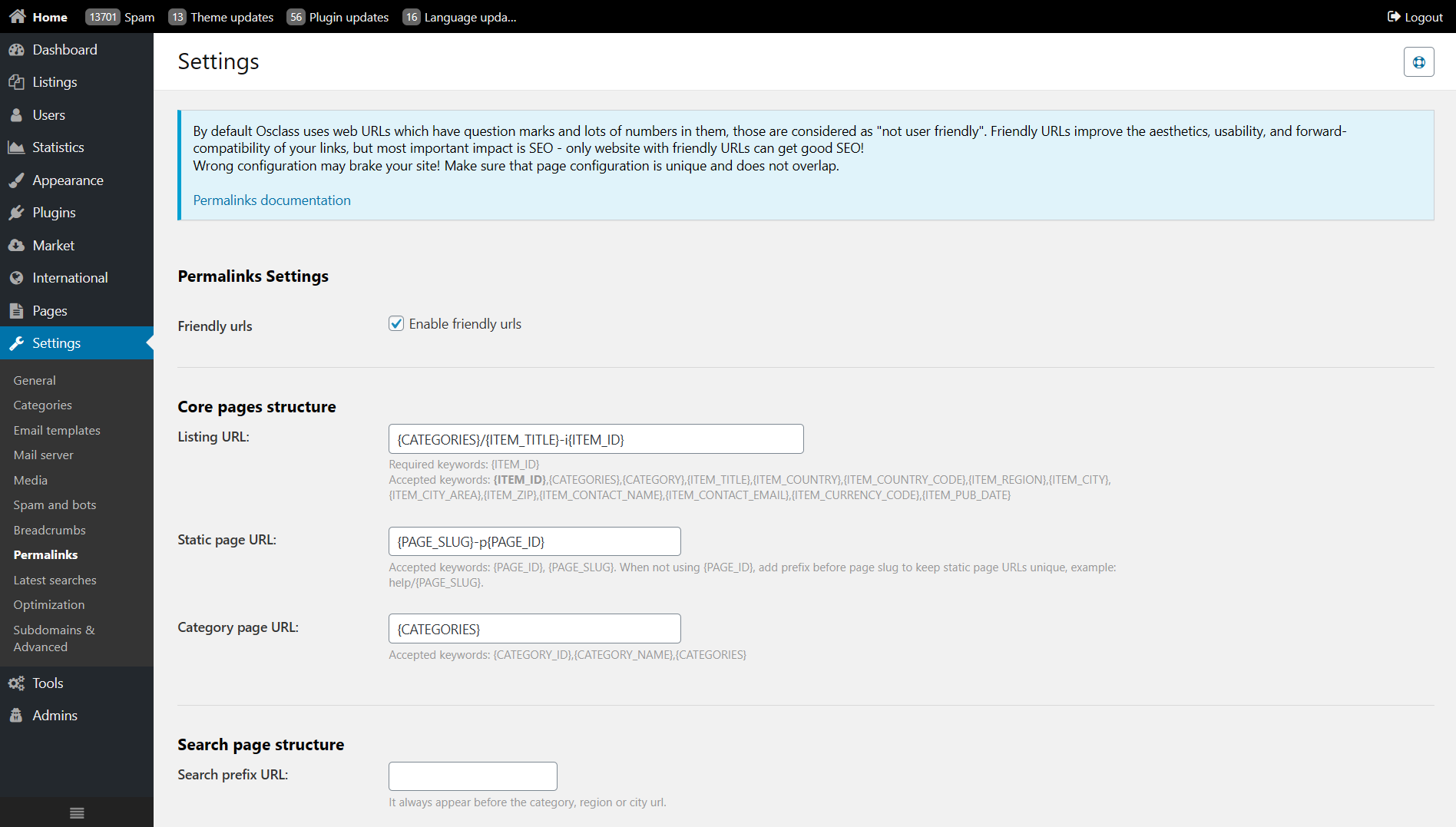By default, Osclass uses URLs with query strings (“?id=123”) that are less readable and less SEO-friendly. Enabling Permalinks lets you replace those with descriptive URLs (e.g., /cars/honda-civic-i123). Doing so can significantly improve your site’s SEO, usability, and future compatibility.
Important: Misconfiguration can break your site or cause overlapping routes. Always ensure each page type has a unique pattern and that your server supports rewrite rules (e.g., Apache mod_rewrite).

.htaccess (on Apache servers) or alternative configuration (for Nginx, Lighttpd, etc.).{CATEGORIES}/{ITEM_TITLE}-i{ITEM_ID}. {ITEM_ID} {CATEGORIES}, {CATEGORY}, {ITEM_TITLE}, {ITEM_COUNTRY}, {ITEM_COUNTRY_CODE}, {ITEM_REGION}, {ITEM_CITY}, {ITEM_CITY_AREA}, {ITEM_ZIP}, {ITEM_CONTACT_NAME}, {ITEM_CONTACT_EMAIL}, {ITEM_CURRENCY_CODE}, {ITEM_PUB_DATE}. {ITEM_ID} or something that differentiates items.{PAGE_ID}, {PAGE_SLUG}. {PAGE_ID}, be sure to add a prefix (e.g., help/{PAGE_SLUG}) so that URLs don’t conflict with other routes.{CATEGORIES}. {CATEGORY_ID}, {CATEGORY_NAME}, {CATEGORIES}.search or listings.search.country might appear in /search/country/spain.{sRegion}/{sCity}/{sPattern}) that override the default search URLs when a matching set of parameters is detected.A through Z. A is the lowest priority, Z the highest. Osclass applies the first matching rule from Z down to A.lang, iPage, sShowAs, sOrder, iOrderType are appended at the end and are not part of custom matching.{sCategory}/{sCity}/{sPattern} could apply to searches containing both a category and city parameter plus a keyword pattern.A to Z. If multiple rules match, Osclass applies the highest priority (closest to Z) first.lang or iPage) will still be appended to the final URL, ensuring all search filters remain in effect.sPriceMin, bPic, or bPremium. Review your theme or plugin documentation to confirm parameter names.Read more about Custom Search Rules.
item/contact) to keep your URLs clean and intuitive.user/login to signin, for example, the login URL becomes https://example.com/signin when using friendly URLs..htaccess file in your site’s root folder. Its contents must redirect all non-file, non-directory requests back to index.php for permalinks to function..htaccess often looks like:
<IfModule mod_rewrite.c>
RewriteEngine On
RewriteBase /
RewriteRule ^index\.php$ - [L]
RewriteCond %{REQUEST_FILENAME} !-f
RewriteCond %{REQUEST_FILENAME} !-d
RewriteRule . /index.php [L]
</IfModule>RewriteBase matches your site’s subdirectory if applicable (e.g. /classifieds/).After finalizing the rules, click Save changes and test your site thoroughly. Confirm that listings, categories, search pages, and user-related pages all resolve to the correct URLs. If URLs return 404 or unexpected results, revert or adjust your settings to fix any conflicts.
The following extra considerations can help you avoid common pitfalls and maximize the benefits of friendly URLs:
{ITEM_ID} from your “Listing URL” pattern, then your site might conflict with similarly named static pages or categories. The required placeholder ({ITEM_ID}) is the simplest way to guarantee uniqueness.en.example.com or newyork.example.com). Osclass offers partial support for subdomains, but you must ensure your DNS and web server configuration properly map subdomains to the main Osclass installation. If you choose this route, additional rewrite rules beyond the standard .htaccess may be required.RewriteBase directive if your site is in a subdirectory..htaccess, or conflicting custom rules within your permalinks configuration.RewriteBase or your custom rule set is causing a loop. Sometimes, rewriting from one path to an identical one triggers endless redirects..htaccess alongside Osclass, or mismatched custom subdomain rules). Keep your rewrite logic consolidated and consistent.By following these guidelines and verifying your site’s URL patterns do not overlap, you can enjoy the SEO and user experience benefits of permalinks without risking broken links or duplicate content. Good testing and backups before big URL changes are always recommended.